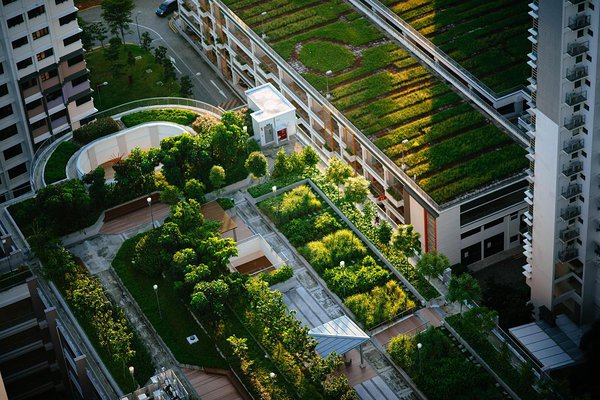The potential (and problems) of green roofs
Have you ever gazed upon the cityscape from up high and admired at how the buldings run out of sight? Perhaps you have noticed that in areas where the price per m² is highest in the whole country, there is so much unused space. Unused space on the roofs. Invaluable space, enjoyed by none. As more and more green space in city centres is lost to commercial or residential areas, we lose a valuable part of our environment. Could roofs have role in solving this problem?
Green roofs (or roof gardens) come in a wide variety of types, differing in type of vegetation, thickness of soil and several other factors playing a role in the construction requirements. Not all roofs can be used as roof gardens, after all. Extensive roof gardens are thinner and lighter in construction, and as such their construction and maintenance is less costly. They mainly consist of a layer of soil or gravel and can only host the most basic of plants. Such roofs do not require an additional irrigation system and almost all roofs are suitable for this purpose. Intensive roof gardens are, as the name suggests, more complicated and can be similar to walkable city parks with trees and diverse vegetation. The layer of soil is thicker and capable of hosting any plant. Intensive gardens require planning at the building construction stage, since the weight applied per unit of roof area is much higher.
What are the practical applications and environmental implications of spending time and money on constructing these parks on rooftops, where they are accessible to but a select few people? Aesthetic considerations aside, green roofs are a strong tool in combating the urban heat island effect. This effect refers to higher temperatures in urban areas, compared to rural areas with more vegetation. Urban infrastructure development comes at the cost of vegetation, changing the micro-climate as the surface temperature (and consequently, the air temperature) increases during the day and reduces cooling at night. The shade provided by vegetation lowers surface temperatures. Additionally, evapotranspiration, whereby plants release water through their stomata, dissipates ambient temperatures by drawing heat away from the surface.
Urban materials have a lower albedo compared to rural areas, meaning that they absorb more solar energy and reflect back less of it. These materials (such as bitumen, steel and stone) have a higher thermal capacity compared to dry soil and vegetation. As a result, the surface temperature is higher. Researchers in Chicago measured the temperature differences of green roofs and conventional asphalt roofs in the city centre. They found that, on a sunny day with little wind, the average surface temperature of a green roof ranged from 33-48°C. For a nearby conventional asphalt roof that value was 76°C. As such, vegetation on green roofs helps buildings stay cool. Compared to a conventional dark roof, less heat is transferred from the roof into the building, which may reduce air conditioning use and costs (benefits of that are addressed in this post). Additionally, green roofs enhance stormwater management by reducing the peak loads of sewage systems.
In terms of combating climate change and the urban heat island effect, green roofs contribute in three distinct ways:
- direct reduction of greenhouse gas emissions.
- dissipation of ambient heat
- keep buildings cooler, indirectly reducing greenhouse emissions by reducing air conditioning use.
Sources
U.S. Environmental Protection Agency. 2008. Reducing urban heat islands: Compendium of strategies. Draft. https://www.epa.gov/heat-islands/heat-island-compendium.
https://www.urbangreenbluegrids.com/measures/green-roofs/
 lines
lines 